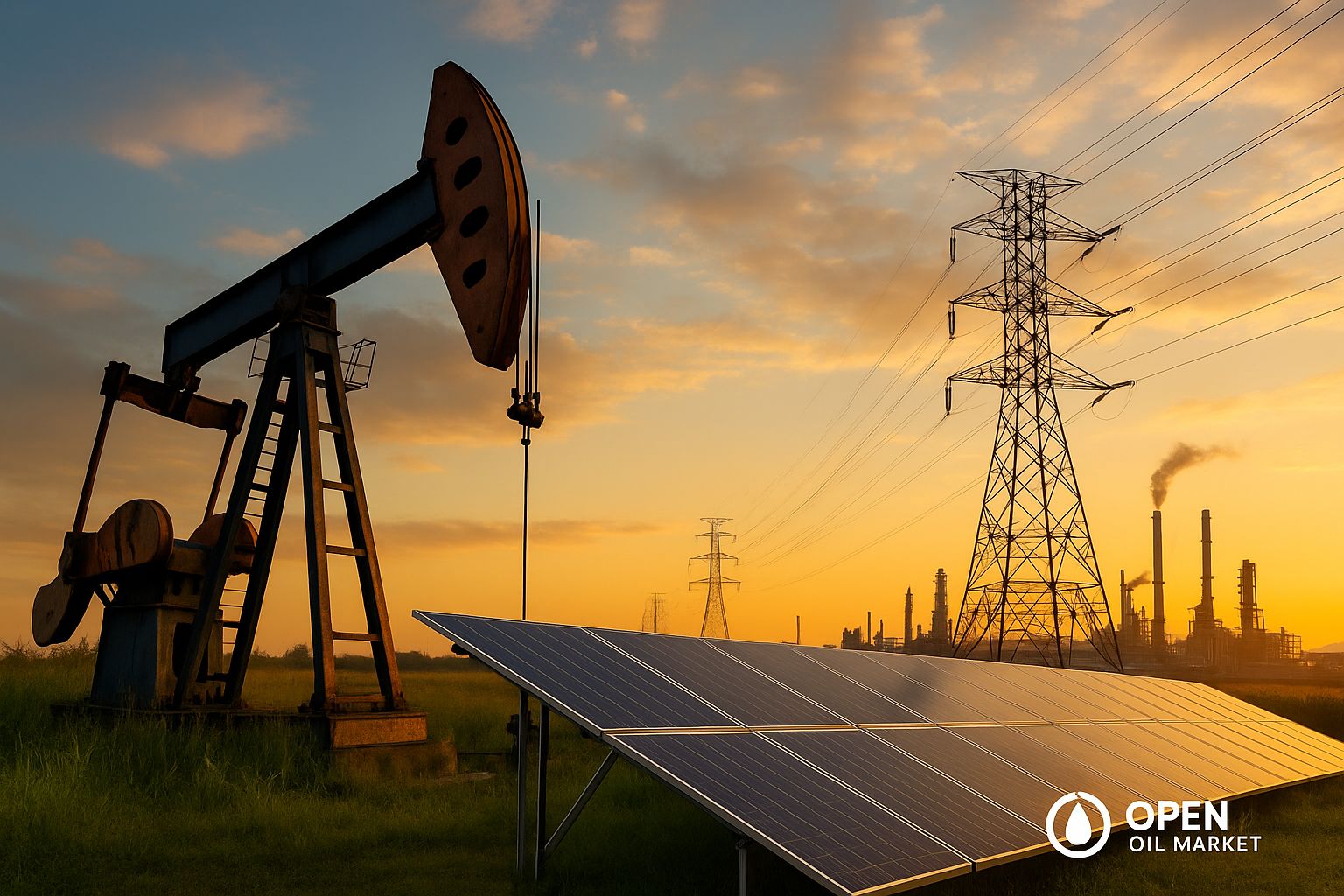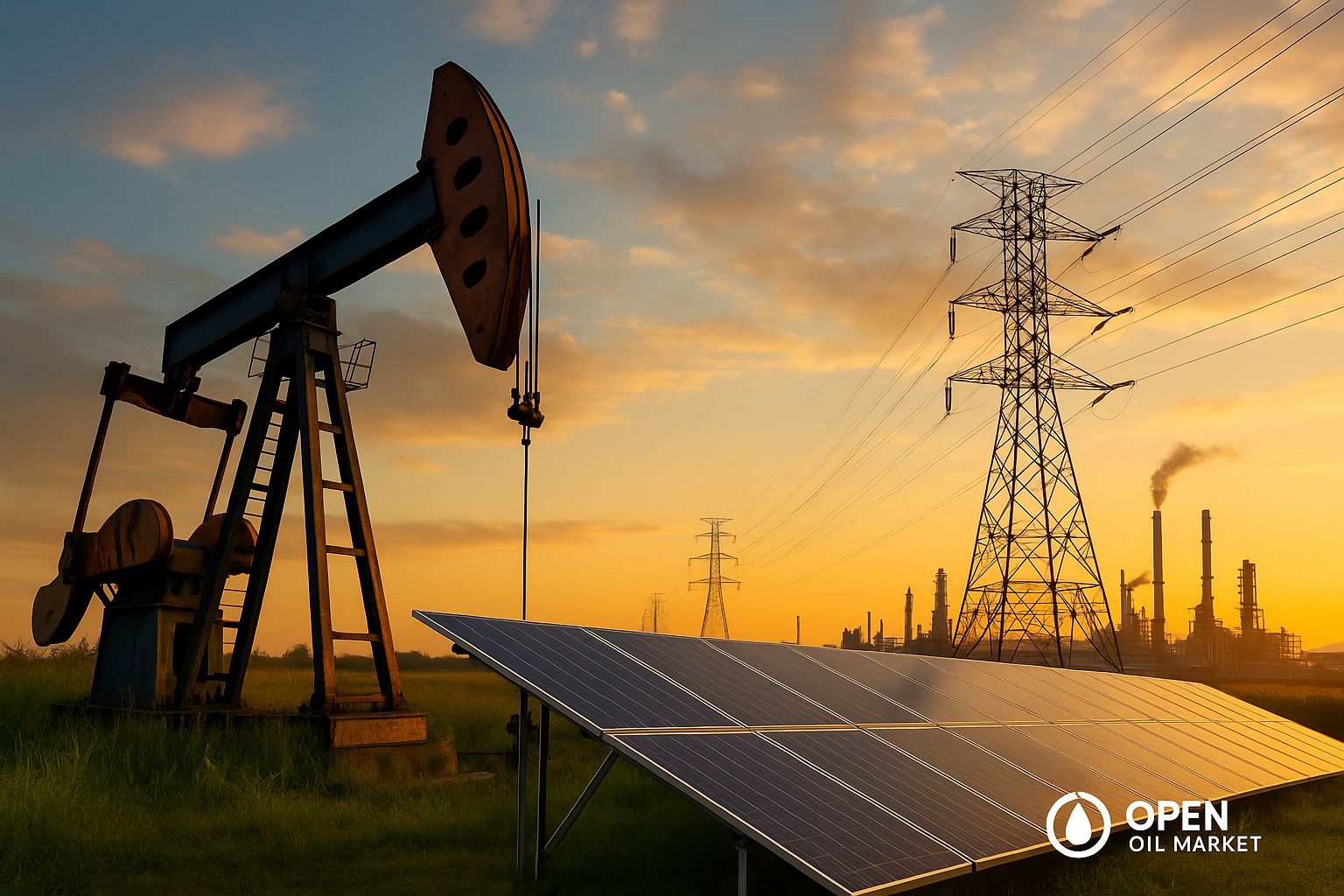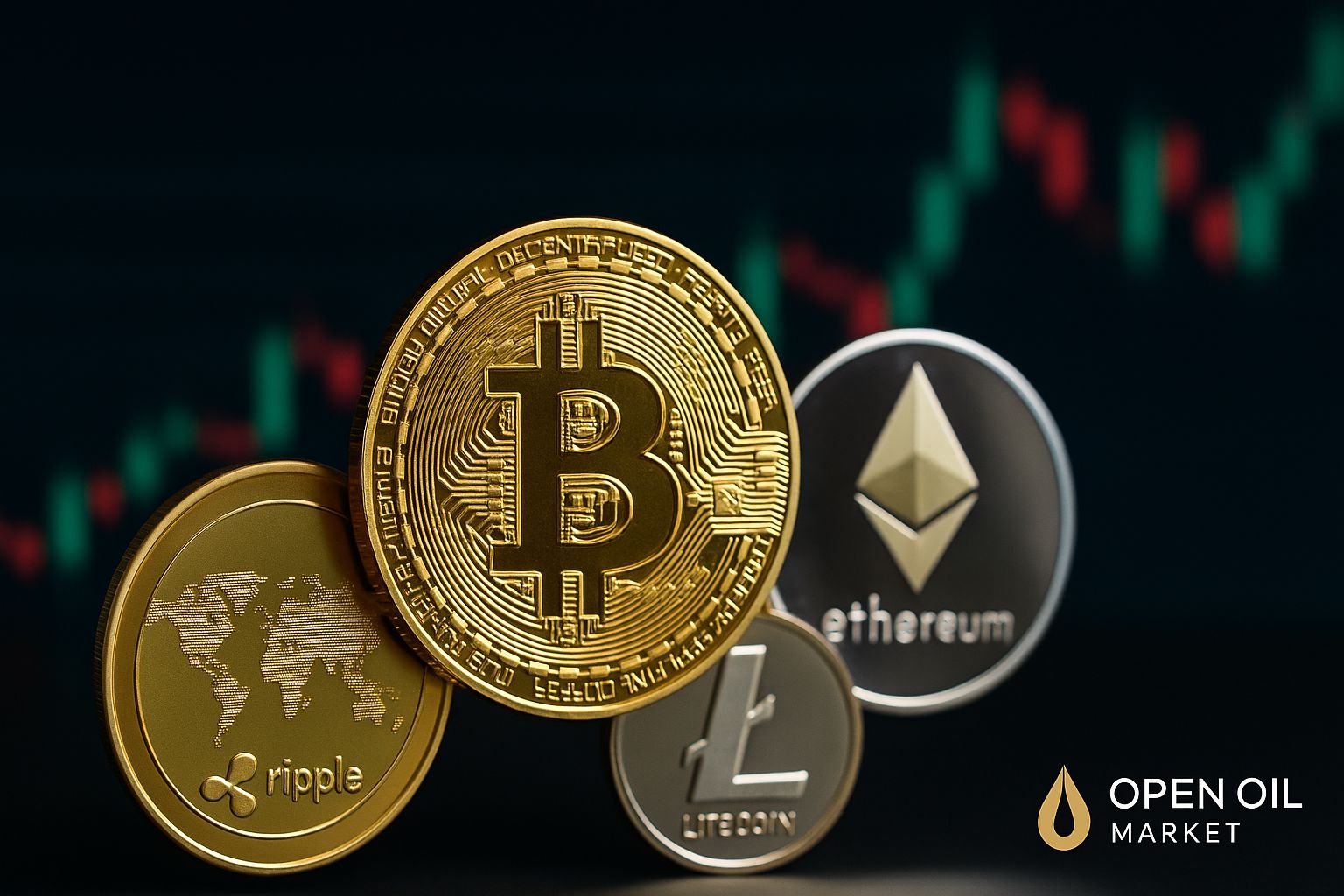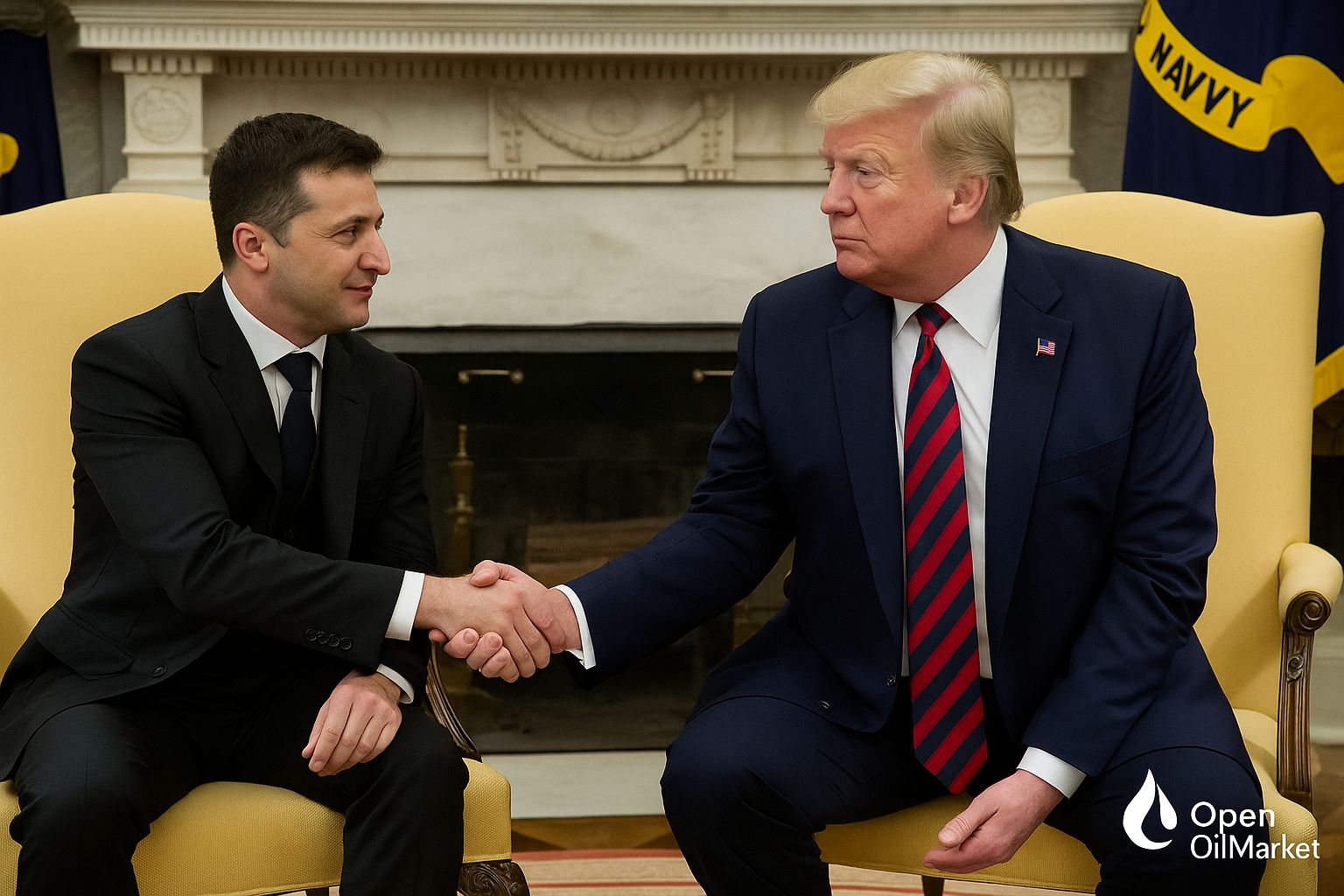
Detailed Review of Global Energy Sector News for Monday, August 18, 2025: Oil, Gas, Coal, Electricity, Renewables, and Fuel Price Stabilization. Analysis of Key Events, OPEC+ Decisions, the Sanctions Dialogue between the U.S. and Russia, and Measures by the Russian Government to Regulate the Fuel Market.
At the start of the new week, relevant events in the fuel and energy sector (FES) attract investors' attention with a combination of geopolitical and market factors. The results of the recent summit between Russia and the U.S. in Alaska did not yield breakthrough agreements; however, both parties expressed a willingness to continue dialogue – fueling cautious optimism regarding a possible easing of sanctions. The oil market continues to feel pressure from rising supply and slowing demand: Brent crude prices hold around the mid-$60 per barrel mark, reflecting a fragile balance of factors. The European gas market remains stable: gas storage levels in the EU near record highs, providing a buffer ahead of winter and keeping prices at a moderate level. The global energy transition is gaining momentum – many countries are seeing new records in generation from renewable sources, although traditional resources are still relied upon for the stability of energy systems. In Russia, after an unprecedented surge in motor fuel prices in the first half of August, the government's emergency measures are gradually cooling the market: the situation with gasoline and diesel supply is starting to stabilize. Below is a detailed overview of key news and trends across the oil, gas, energy, and commodity markets as of August 18, 2025.
Oil Market: Supply Surplus and Weak Demand Limit Price Growth
Global oil prices maintain relative stability, influenced by fundamental factors. The North Sea benchmark Brent trades around $65-$66 per barrel, while U.S. WTI is in the range of $62-$64. Current levels are approximately 10%-15% lower than a year ago, reflecting a gradual market correction following the peaks of the 2022-2023 energy crisis. Several important factors influence price dynamics simultaneously:
- OPEC+ Production Increase. The oil alliance is steadily increasing supply in the global market. In August 2025, the total production quota of the main participants in the deal has been raised by approximately 548,000 barrels per day; a comparable increase is expected in September. From April to July, restrictions have been successively eased, leading to a rise in global oil and petroleum product stocks.
- Decreased Demand Growth Rates. Global oil consumption growth is slowing down. The International Energy Agency (IEA) has lowered its forecast for demand growth in 2025 to about 0.7 million barrels per day (compared to a rise of more than 2.5 million barrels per day in 2023). Even OPEC's forecasts are currently more restrained – around +1.3 million barrels per day in 2025. The reasons include a weakening global economy and the effect of previous high prices stimulating energy conservation. An additional factor is the slowdown in industrial growth in China, which limits the appetite of the world's second-largest oil consumer.
- Geopolitical Uncertainty. The market is pricing in conflicting risks amid U.S.-Russia negotiations. On one hand, lack of significant progress means continued sanctions pressure and the threat of new restrictions (Washington previously threatened to impose 100% tariffs on Russian oil if peace efforts fail). These risks maintain a "risk premium" in prices. On the other hand, the mere fact of ongoing dialogue among leaders instills hope for a gradual easing of certain barriers in the oil and gas sector, which restrains extreme fluctuations. As a result, prices fluctuate within a narrow range, lacking momentum for either a new rally or a decline.
The combined influence of these factors creates a supply surplus over demand, keeping the oil market close to a state of oversupply. Prices remain significantly below last year's highs, and several analysts estimate that if current trends continue, the average Brent price could drop below $50 per barrel in 2026.
Gas Market: Europe Increases Reserves, Prices Remain Moderate
In the gas market, attention is primarily focused on Europe, where accelerated injection of fuel into underground storage is ongoing ahead of winter. As of mid-August, European gas storage facilities are over 86% full, confidently moving towards the target level of 90% set for early November. Such a high reserve provides a serious buffer ahead of the heating season and already helps keep prices within reasonable limits. Exchange gas prices remain relatively low: September futures at the TTF hub are trading around €33 per MWh (approximately $400 per thousand cubic meters), reflecting a balance of supply and demand. Comfortable storage levels and reduced consumption (thanks to mild weather and conservation measures) have reduced the chances of a repeat of the price spikes seen in 2022. Thus, the European gas market enters the autumn in a stable condition, showing no signs of shortages on the horizon.
International Politics: Ongoing U.S.-Russia Dialogue Inspires Hopes for Cooperation
Foreign policy factors continue to significantly influence the sector. On August 15, negotiations between the presidents of Russia and the U.S. took place in Anchorage, Alaska. Although there was no direct breakthrough from the meeting, both sides agreed to continue discussions on trade, economic, and energy issues. Vladimir Putin noted that there are opportunities for energy cooperation between Russia and the U.S. under favorable conditions. The sanctions regime remains in place, but the very fact that high-level dialogue has resumed is viewed positively by market participants, with hopes for a reduction in geopolitical tensions in the future. In the coming weeks, market attention will be focused on further contacts: positive shifts could improve investor sentiment and soften the sanctions rhetoric, while a failure in dialogue threatens to escalate restrictions. Consequently, the results of the Alaska summit may have long-term implications for energy cooperation and sanctions policy.
"The list of potential bilateral projects in energy is extremely broad – from oil production in the Kara and Okhotsk seas to the import of technologies for LNG production and supplies of Russian oil for American refineries using high-sulfur feedstock. Specific directions will depend on the speed of sanctions lifting and assessments by American companies of the long-term prospects for doing business in Russia," stated Sergey Tereshkin, CEO of Open Oil Market, in a comment to the agency “Pravda”.
He also emphasized: "Overall, cooperation is more beneficial for both parties than restrictions, which prevent Russian companies from supplying energy resources to the U.S., and close the Russian market for American equipment manufacturers."
Thus, there remains hope on the diplomatic front that the gradual mitigation of contradictions will allow for a new chapter in energy partnership between Moscow and Washington. However, concrete decisions largely depend on political will and guarantees related to the lifting of sanctions.
The Middle East: OPEC Strategy and Investment in Production
Key oil producers in the Middle East are striving to maintain market balance while also planning long-term expansion of the sector. Gulf countries, led by Saudi Arabia, adjust production levels according to market conditions within the OPEC+ agreement – in the event of an oversupply, additional restrictions might be imposed, while in times of shortage, they are prepared to increase supplies to prevent sharp price spikes. Simultaneously, countries in the region are investing significant resources in expanding capacities and modernizing infrastructure:
- Saudi Arabia. The country is implementing large-scale projects to increase oil production. Saudi Aramco is investing in expanding production capacity with the aim of reaching a production potential of 13 million barrels per day by the end of the decade. The kingdom is also developing petrochemical complexes and hydrogen export programs, preparing to diversify its energy business.
- UAE. The UAE is increasing production and exploring new fields. Abu Dhabi National Oil Company (ADNOC) is steadily increasing the oil potential of the Emirates (targeting around 5 million barrels per day in the coming years), while also investing in renewable energy and carbon capture technologies to reduce the sector's carbon footprint.
- Iran. Despite sanctions, Iran has increased oil exports through alternative routes, primarily to Asian countries. It is estimated that Iranian oil exports in 2025 have approached 1.5 million barrels per day. Should sanctions be lifted, Tehran could quickly increase exports, significantly impacting market balance – this factor is considered by other OPEC participants when planning quotas.
Thus, Middle Eastern producers balance between the short-term task of maintaining market stability and a long-term strategy for sector development. On one hand, coordinated OPEC+ efforts allow them to avoid extreme price scenarios. On the other hand, extensive investments in production, refining, and new energy technologies aim to ensure they remain leaders even amidst the global energy transition.
Energy Transition: New Successes in Renewables and the Importance of Traditional Generation
The global shift to clean energy continues to accelerate. In European countries, by the end of 2024, the total electricity generation from solar and wind sources surpassed that of coal and gas power plants for the first time. This trend continued into 2025: the introduction of new renewable energy capacities increases the share of "green" electricity, while coal’s role in the EU’s energy balance decreases (after a brief rise during the 2022-2023 crisis). In the U.S., renewable energy has also reached record levels – by early 2025, more than 30% of electricity generation came from renewables, and the total generation from wind and solar has for the first time surpassed that from coal plants. China, being the world leader in installed renewable capacity, installs tens of gigawatts of new solar panels and wind turbines annually, continually breaking its own records for "green" electricity.
At the same time, energy systems still rely on traditional generation for stability. The growth in the share of solar and wind creates challenges in balancing the grid during hours when renewables are not generating power (e.g., at night or during calm weather). To cover peak demand and ensure reserve capacity, operators sometimes need to increase production from gas and even coal plants. For instance, in several European countries last winter, coal plants were temporarily brought back online during prolonged windless periods, despite environmental costs. To enhance reliability of power supply, governments are actively investing in energy storage systems (industrial batteries, pumped-storage hydroelectric stations) and smart grids able to respond flexibly to fluctuations in generation. Experts predict that by 2026-2027, renewable sources could lead the world in terms of electricity generation, finally surpassing coal. However, in the coming years, there remains a necessity to keep some conventional power plants on standby as a safeguard against interruptions. Thus, the energy transition is reaching new heights but requires a delicate balance between "green" technologies and traditional resources.
Coal: High Demand Persisting in a Stable Market
Despite the active development of renewable energy, the global coal market continues to rely on significant demand and remains a vital part of the global energy balance. Coal consumption is particularly high in the Asia-Pacific region, where economic growth and electricity needs support intensive use of this fuel. China, as the world's largest consumer and producer of coal, in 2025 maintains coal burning at near-record levels. Each year, Chinese mines produce over 4 billion tons of coal, covering most of domestic needs, although this is barely sufficient during peak demand times (such as hot summers with widespread air conditioning use). India, with substantial coal reserves, is also increasing its usage: more than 70% of the country's electricity is generated from coal-fired power plants, and absolute consumption rises alongside the economy. Other developing Asian countries (such as Indonesia, Vietnam, Bangladesh, and others) are implementing new coal power projects to meet the growing demands of populations and industries.
Global coal market supply has adjusted to high demand. Major exporters – Indonesia, Australia, Russia, and South Africa – have increased production and export of thermal coal in recent years, keeping prices relatively stable. Following the price spikes of 2022, prices have returned to more normal levels and have fluctuated within a narrow range in recent months. The balance of supply and demand appears to be stable: consumers are receiving the necessary fuel, while producers enjoy consistent sales at profitable prices. Although many countries declare plans for a gradual reduction in coal use for climate goals, in the short term, this resource remains indispensable for powering billions of people. Expert assessments converge on the outlook that in the next 5-10 years, coal-based generation, especially in Asia, will maintain a significant role, despite global decarbonization efforts. In other words, the coal sector is currently experiencing a period of relative equilibrium: demand remains consistently high, prices modest, and the industry continues to serve as one of the pillars of global energy supply.
Russian Oil Products Market: Initial Effects of Price Stabilization Measures
In the internal fuel market of Russia, after a sharp price spike in early August, signs of stabilization are beginning to emerge due to government intervention. In the first half of the month, exchange prices for automotive gasoline and diesel reached historic highs, surpassing even the peaks of 2023. Amid heightened summer demand (the vacation travel period and active harvesting campaigns), limited fuel supply led to local shortages and speculative price increases. The government swiftly enhanced regulation: on August 14, under the chairmanship of Deputy Prime Minister Alexander Novak, a meeting of the monitoring task force for the FES took place, which resulted in a set of steps announced to quell price surges, including:
- Extension of the Fuel Export Ban. The complete ban on exporting automotive gasoline and diesel fuel, implemented in early August, has been extended until the end of September and is applied to all producers, including vertically integrated oil companies. This measure aims to increase domestic market supply from volumes that were previously exported.
- Partial Resumption of Exports in October. It is planned that if the situation stabilizes, the largest oil refineries will be allowed to partially resume exports starting in October; however, for independent tank farms, traders, and small refineries, the export embargo will likely remain until the situation normalizes.
- Strengthened Fuel Distribution Control. One of the causes of the supply shortage was unscheduled shutdowns of several refineries (including due to emergencies and drone attacks), which reduced gasoline output. Authorities have tightened monitoring of resource distribution within the country: refineries are instructed to prioritize domestic market needs and avoid mutual exchange on exchanges that previously drove up prices. The Ministry of Energy, along with the Federal Antimonopoly Service and the St. Petersburg International Commodity Exchange, is developing measures to transition to direct contracts between refineries and sales companies, bypassing exchanges to eliminate unnecessary intermediaries.
- Subsidies and Price Dampening Mechanism. Continued financial compensation for oil companies is being provided (budget subsidies and reverse excise – "dampener"), to reimburse some of the lost export revenues and encourage the redirection of sufficient volumes of gasoline and diesel onto the domestic market.
The totality of these measures aims at stabilizing prices and preventing fuel shortages for consumers. The extension of the export ban is expected to ensure an additional 200-300 thousand tons of gasoline and diesel entering the domestic market over the next month (these were the volumes previously exported monthly). At the same time, subsidies are intended to support profitability for sales at gas stations within the country. The government assures it will act proactively: if the situation requires, restrictions on petroleum product exports may be extended, and fuel from reserves will be sent to regions promptly. At this point, the "fuel crisis" is being contained: despite extreme values in exchange prices, retail prices at gas stations have risen by only about 5% since the start of the year, closely aligning with overall inflation levels. Authorities are intent on avoiding a repeat of last year's scenario, when spikes in gasoline prices in certain months significantly impacted motorists and agricultural producers. Currently, most gas stations are adequately supplied with fuel, and it is expected that the implemented measures will gradually cool the wholesale fuel market. Monitoring the situation continues at the highest levels – relevant agencies and the government are ready to introduce new mechanisms to ensure stable fuel supply to the country and keep prices within acceptable limits for end consumers.
OPEN OIL MARKET Telegram Channel – Daily Analytics on Energy Market
To stay updated on current events and trends in the fuel and energy market, subscribe to our Telegram channel @open_oil_market. There, you will find daily reviews, industry insights, and only verified facts without unnecessary informational noise – all the important information for investors and FES specialists in a convenient format.




